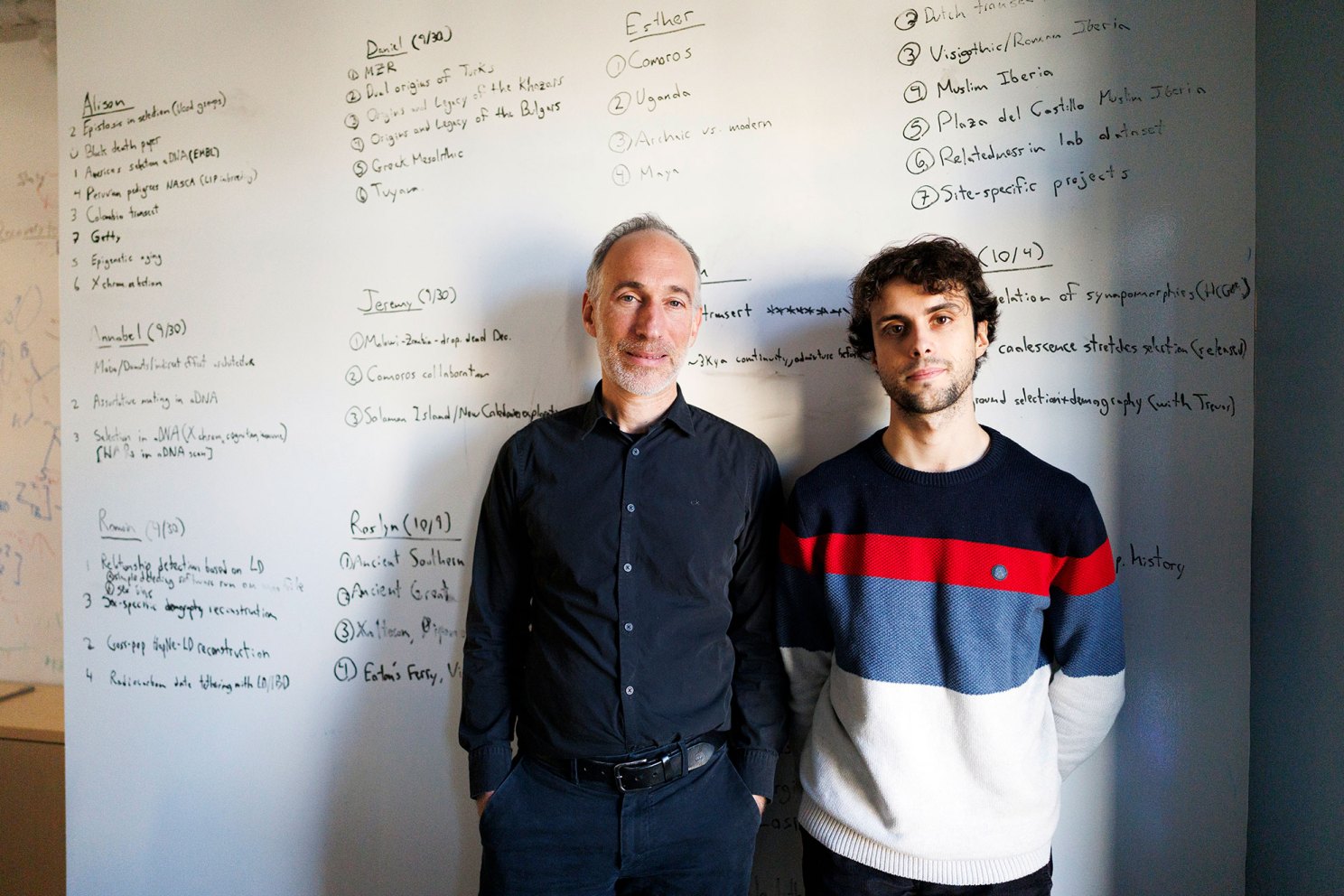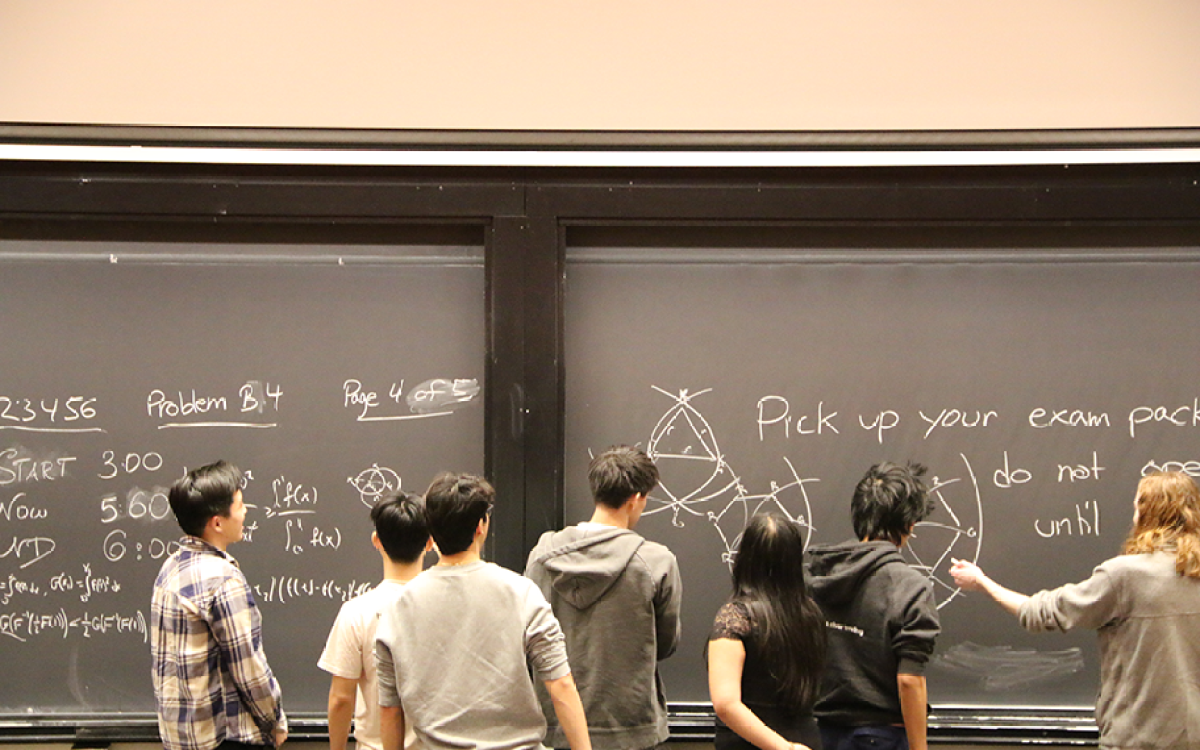Solving mystery at tip of South America

David Reich (left) and Javier Maravall Lopez.
Stephanie Mitchell/Harvard Staff Photographer
Study finds previously unknown ancient lineage of indigenous people, which gave rise to surprisingly diverse mix of cultures
The southern tip of South America was one of the last regions of the world to be populated by modern humans, but the early history of settlement has remained murky.
A new study by Harvard researchers sheds new light on this mystery with the discovery of a previously unknown ancient lineage that endured for more than eight millennia and gave rise to a surprisingly diverse mix of indigenous cultures.
“We found this new lineage, a new group of people we didn’t know about before, that has persisted as the main ancestry component for at least the last 8,000 years up to the present day.”
Javier Maravall López
“We found this new lineage, a new group of people we didn’t know about before, that has persisted as the main ancestry component for at least the last 8,000 years up to the present day,” said Javier Maravall López, lead author of the new paper and a Ph.D. student studying human evolutionary biology at the Kenneth C. Griffin Graduate School of Arts and Sciences. “It’s a major episode of the history of the continent that we just weren’t aware of.”
In a paper published in Nature, a team of international researchers analyzed DNA from more than 230 ancient people going back 10,000 years in the central Southern Cone of South America, an area roughly bounded by the Andes Mountains, Amazon rainforest, and the grassy plains of the Pampas. Most of the DNA samples came from modern-day Argentina.
The southern tip of the Americas was one of the last corners of the globe reached by the diaspora of modern humans. The oldest firmly established evidence of human presence in the region is an archaeological site about 14,000 years old at Arroyo Seco in the Pampas of Argentina (when it was settled remains a hotly contested topic, and some scholars contend that the region was populated thousands of years earlier).
Previous genetic studies have shown that by 9,000 years ago Native Americans had begun to differentiate into three identifiable groups: one in the central Andes, another in the tropical lowlands of Amazonia, and a third to the south in the Pampas, Chile, and Patagonia. But much of the population history remained unknown, and studies of ancient DNA have lagged behind efforts in Europe and Asia.
“This part of the world was almost a blank spot on the map,” said David Reich, professor of genetics at Harvard Medical School, professor of human evolutionary biology, and senior author of the new paper. “Like most of South America, there was very little data.”
In the new study — a collaboration of 68 co-authors across the globe — researchers obtained new samples of ancient DNA from bones and teeth of 238 indigenous individuals up to 10,000 years old.
“This part of the world was almost a blank spot on the map.”
David Reich
The new study boosted the number of ancient DNA samples from the central Southern Cone more than 10-fold. These new data were combined with existing ancient DNA from 588 other indigenous people from across the Americas who lived from 12,000 years ago up to the time of European contact.
Researchers sequenced the ancient DNA and focused on a select set of 2 million positions on the genome known as single-nucleotide polymorphisms (SNPs), which vary between humans. With statistical analysis, researchers can make inferences about the genetic relationships among the individuals — and identify which ones shared common ancestry and which were more distantly related.
They discovered a lineage that appeared by 8,500 years ago and became the core component of the ancestry of central Argentina, mixing with other populations on its edges.
This finding is intriguing because the people of that region developed a diverse array of languages and cultures. Apparently, that diversity grew on home soil among largely homogeneous populations — not from migrations by other peoples.
“People with the same ancestry, in an archipelago-like fashion, were developing distinctive cultures and languages while being biologically isolated,” said Maravall López.
All told, the researchers found the region hosted at least three “deep lineages”: the newly discovered one in central Argentina, another present in the Andes by about 9,000 years ago, and a third established in the Pampas by 7,700 years ago.
This newly identified central Argentina lineage expanded to the south, mixed with the Pampas population 3,300 years ago or earlier, and, eventually, became the dominant ancestry.
In the northwest, the central lineage interbred with another ancient population from the Andes region, possibly by 4,600 years ago.
Researchers also found hints of the common ancestors of all these populations.
One person who lived in the Pampas about 10,000 years ago belonged to a population that already had become distinct from others in the Andes and Amazonia — and had genetic similarities to all later peoples in the Southern Cone.
In future studies, researchers hope to fill in the remaining gaps in the timeline and geography of these ancient Americans. In Europe, Central Asia, and China, researchers are building large databases with increasingly dense samples from specific places and time periods.
Reich hopes similar databases will be assembled in South America.
“With large ancient DNA sample sizes it is possible to learn details about the questions that really matter to many archaeologists — questions about how people are related to each other at a fine scale within archaeological sites as well as regionally,” he said. “With ancient DNA data technology now, it is possible to build refined maps of population size change and migration, as now exist in rich detail in Europe, and as this study begins to do for Argentina. Such maps are transformative for our understanding of how people lived long ago, revealing demographic information about the past that was simply inaccessible before.”





